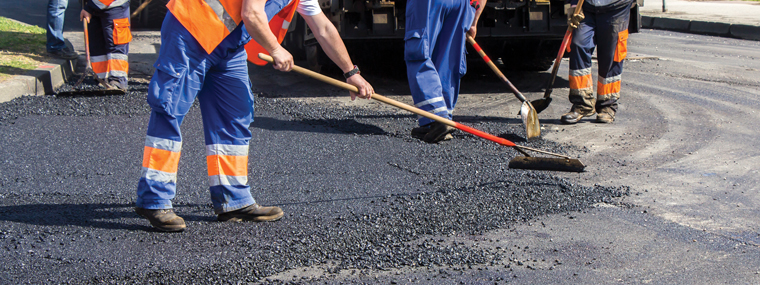
Let Me Tell You about Your Asphalt!
By Connie Lorenz / Published April 2020

If there is something I can count on at every class and conference, it is for a board member or property manager to come up and ask the same questions over and over. I really don’t mind answering but thought maybe we should also share these questions with the universe so we can move on to more important topics, like who was the winner of the flat screen TV at booth 301! So, to keep you in the loop, here are some of the questions I get asked regularly.
When is the best time to start an asphalt maintenance program?
The type of surface treatment you choose would determine the best time to begin an asphalt maintenance program. Also, when making this decision, make sure to take into consideration the right product, for the right place, applied at the right time.
With new asphalt, you can begin a sealcoating or rejuvenation program within six months of a new overlay. But, remember; just because you can, doesn’t necessarily mean you should. There are many factors to take into consideration when setting up an asphalt maintenance program. My first piece of advice is to set up a program for the community and not the current sitting board!
If you have board members coming from one of our northern states where they sealcoat their roadways and parking areas every year, then it’s going to cost you! Our northern states that have a freeze/thaw cycle and snow are subjected to far harsher climates than we are here in Florida. Up north, their roadways are constantly being salted and then snow plowed regularly. This annual process “scrapes” up water-based emulsions like sealcoating.
Since we don’t have snow or snowplows, we don’t have the same need for reapplication and can usually get three to five years between applications, depending again on multiple factors such as traffic, weather, parking areas versus roadways, etc. Over-applying water-based sealers in Florida will have a detrimental effect to your pavement, as the sealcoating is a harder surface than your asphalt and expands and contracts differently, resulting in cracking from the top down. Over applying a sealcoating will cause these cracks to become larger and larger until eventually a new overlay is needed.
Starting an asphalt maintenance program using an asphalt rejuvenator depends on what type of rejuvenator it is. If it’s an over-glorified water-based emulsion that plays on the word rejuvenator, see above. If it’s truly an asphalt rejuvenator that is designed to penetrate your asphalt cap and replenish the oils that have been lost due to oxidation, then you are on the right track to extending the life of your current asphalt cap. Remember, though: right product, right time, right place!
What is the best way to repair a pothole in my roadway?
I always recommend that the best way to repair a pothole is to extend your area of repair to one foot past the edge of each side of the defect. If you have a one foot by one foot pothole, then you want the contractor to repair at minimum a three-feet-by-three-feet area of correction. This allows the contractor to complete the repair in its entirety rather than just fixing the exposed area. The pothole is the area that has failed already; the extended area is what hasn’t failed yet but has been weakened by the open asphalt.
Asphalt is a compacted matrix that likes to be compressed to a density that allows minimal movement. When we have no curbs and gutters in place, for example, a community will start to notice the edges of their pavement starting to ravel and fail. Concrete curbing and gutters act as “footer holds” for our asphalt cap and keep it from spreading out under the weight of traffic. Without curbing, your asphalt continues to compact and spread, and the edges of your pavement become weak and fail. This works the same way when voids are present in your asphalt cap, whether it is in the form of a pothole, an open drain line, or an open area between your concrete and asphalt cap.
Once the area of concern is noted, I recommend that the contractor saw cut out the existing asphalt cap and remove all debris. When the area is open, they need to stabilize the sub-base to ensure there is no shifting. Once the area is stabilized, the contractor should apply tack to the edges of the repair and then install a hot mix asphalt to be about ¼-inch above the surrounding pavement. The contractor should then lute the asphalt to make sure it is level and compact it with a plate compactor or roller, depending on the size of the repair.
How long is a new one-inch asphalt overlay supposed to last?
That answer is based on the type of asphalt mix installed, what was in place previously, and whether or not the previous asphalt cap was removed prior to paving. A lot of communities have in their reserves that their current asphalt cap might possibly have had a 20-year life expectancy and may find that they are falling short of their projections.
Unfortunately, in Florida most of the communities barely have a one-inch asphalt cap and don’t really have a lot to work with. If we overlaid a roadway that was in pretty good condition, we might very well get 20 years out of the newest asphalt cap. What some boards aren’t aware of is that we haven’t had a one-inch asphalt cap last 20 years in almost 30 years since they changed the asphalt mixes. If you are one of those communities, you are going to be in for a rude awakening when you have to replace your roadways sooner!
I don’t want to invest in a new paving project because I won’t be around long enough to enjoy it!
Sadly, I hear this more often than not, probably because I seem to specialize in 55 and older communities. First off, it makes me sad to think that a board member would choose their own mortality over what is best for the community. Secondly, it is a board’s fiduciary responsibility to maintain a community to the best of their ability. This is selfish thinking and has no place in a conversation when it comes to doing what is right for a community.
When is the best time to complete a paving project?
Nothing is ever easy to answer in asphalt! In Florida, you can pave any time of the year, but you also have to take into consideration our rainy season, holiday seasons, and, of course, our snowbird season! I personally prefer to pave in the fall and winter as there is less curing time, and I can get my residents back into their homes sooner. Additionally, the new asphalt is more forgiving in the cooler months and doesn’t scuff up as much as it does when paving in our warmer months. If you’re thinking of paving during our rainy season, good luck! Be prepared for constantly changing schedules and delays that could extend out over months, depending on the size of your community.
What is an infrared repair, and can you do it on all repairs?
Infrared repairs are some of my favorite types of repairs, and I like to refer to them as “seamless” repairs as there is no seam once the repair is completed. Infrared machines have been around for years, but not many companies own them as they feel it is easier to just remove the area of defect and replace it with new asphalt. After all, newer is better!
I believe that there is nothing better than what you have already, and if you have a ponded area or a shoved area, then infrared is the way to go. I work as an asphalt consultant and see a lot of paving companies that use a blow torch and a plate compactor to correct some of the defects after they complete their paving project.
The downside of this type of correction is that the torch can only heat up an area of asphalt about the size of a large grapefruit. The plate compactor has a plate that is two-foot-wide, and therefore any area of pavement that isn’t heated to be manipulated will have the stone crushed while the area of issue is corrected. This crushed stone changes the mix design, and without replenishing the oils that the torch master burned off during the heating of the area, this area most likely will fail first.
Infrared machines extend on top of the entire area and bring the existing asphalt up to a temperature where it can be manipulated and compacted. Once the asphalt is heated to the right temperature, depending on the type of repair being corrected, the contractor would add new asphalt, apply some rejuvenation to the area, lute the new and old asphalt mixes together, and then compact to be flush with the surrounding pavement. If completed correctly, this is by far the best way to repair asphalt when applicable.
Connie Lorenz
Owner, Asphalt Restoration Technology Systems Inc. (AR Tech)
Asphalt Restoration Technology Systems Inc. (AR Tech) is led by Connie Lorenz, also known as the “Asphaltchick,” and provides education and consultation services on pro-per asphalt maintenance. As a multi-year recipient of the Florida Reader’s Choice Award and Pulse of the City Awards, and one the of Top 50 Asphalt Contractors in the country four years and running through Pavement Maintenance and Reconstruction Magazine, we are the team to turn to! We provide a no-cost, detailed evaluation, property specific, with our proposals and offer board presentations to explain the different options available for pavement maintenance today. For more information on Asphalt Restoration Technology Systems, call (800) 254-4732 or visit www.asphaltnews.com.




